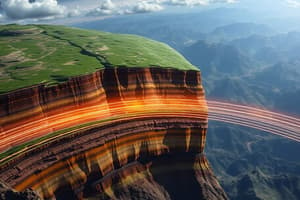Podcast
Questions and Answers
What is the primary composition of the oceanic crust?
What is the primary composition of the oceanic crust?
- Granodiorite
- Basalt (correct)
- Peridotite
- Gabbro
Which layer of the Earth is described as the 'weak sphere'?
Which layer of the Earth is described as the 'weak sphere'?
- Outer core
- Asthenosphere (correct)
- Lower mantle
- Lithosphere
How thick is the continental crust on average?
How thick is the continental crust on average?
- 7 km
- 35 km (correct)
- 40 km
- 22 km
What defines the boundary between the crust and the mantle?
What defines the boundary between the crust and the mantle?
Which of the following layers contains the Earth's solid inner core?
Which of the following layers contains the Earth's solid inner core?
What is the dominant rock type found in the uppermost mantle?
What is the dominant rock type found in the uppermost mantle?
Which layer is more than 82% of Earth's volume?
Which layer is more than 82% of Earth's volume?
What is the characteristic of the lithosphere?
What is the characteristic of the lithosphere?
What is the primary function of the asthenosphere in relation to tectonic plates?
What is the primary function of the asthenosphere in relation to tectonic plates?
Which of the following accurately describes the mesosphere?
Which of the following accurately describes the mesosphere?
What characterizes the biosphere?
What characterizes the biosphere?
How does Earth's internal source of energy primarily arise?
How does Earth's internal source of energy primarily arise?
What role does solar energy play in Earth's energy budget?
What role does solar energy play in Earth's energy budget?
Which definition correctly describes a heterotroph?
Which definition correctly describes a heterotroph?
What distinguishes the hydrosphere from the other spheres of Earth?
What distinguishes the hydrosphere from the other spheres of Earth?
What is the gravitational value of Earth at its surface?
What is the gravitational value of Earth at its surface?
Flashcards are hidden until you start studying
Study Notes
Earth's Characteristics
- Third planet from the sun and classified as a terrestrial planet.
- Known as the "blue planet" due to extensive water coverage (global ocean).
- Unique in its ability to support life.
- Oblate spheroid shape, slightly flattened.
Earth's Interior Structure
-
Crust: Thin solid outer layer divided into continental and oceanic crust.
- Continental Crust:
- Approximately 35 km thick, may exceed 70 km in mountains.
- Composed mainly of granodiorite.
- Oceanic Crust:
- Roughly 7 km thick, primarily made of basalt.
- Continental Crust:
-
Mantle:
- Constitutes over 82% of Earth's volume, extends to nearly 2,900 km deep.
- Dominated by peridotite, richer in magnesium and iron.
- Divided into upper and lower mantle with lithosphere and asthenosphere layers.
-
Lithosphere:
- Rigid outer layer comprising crust and upper mantle.
- Relatively cool and stable.
-
Asthenosphere:
- Below lithosphere, characterized by a small amount of melting.
- Allows tectonic plate movement.
-
Lower Mantle:
- Very hot and flows gradually; strengthens with depth due to pressure.
-
Core:
- Central region composed of an iron-nickel alloy.
- Divided into outer (liquid) and inner (solid) core.
Earth's Gravity
- Constant gravitational acceleration at Earth's surface is 9.8 m/s².
Earth as a System
- Systems encompass individuals, populations, communities, and ecosystems.
- Individual: Single species member.
- Population: Group of the same species in a specific area.
- Community: Different species interacting in a common area.
- Ecosystem: Community interactions with abiotic environmental factors.
Earth's Four Spheres
-
Hydrosphere:
- Contains all water, circulates within oceans, continents, glaciers, and atmosphere.
- Oceans hold 71% of Earth's waters, consisting of 97.5% of all water.
-
Atmosphere:
- Gaseous envelope above Earth's surface, includes multiple layers: troposphere, stratosphere, mesosphere, thermosphere, exosphere.
-
Geosphere:
- Comprises solid Earth, including the core, mantle, and crust.
-
Biosphere:
- Thin layer supporting all life forms on land, in water, and in air.
Earth's Energy Budget
-
Internal Source:
- Heated by radioactive decay and gravitational contraction, providing energy through convection.
-
External Source:
- Solar energy is primary external energy source, sustaining life and warming Earth's surface and atmosphere.
Biotic Groups
-
Autotrophs (Producers):
- Organisms that produce their own food; includes plants, algae, certain bacteria, and phytoplankton.
-
Heterotrophs (Consumers):
- Organisms that cannot produce their own food; includes animals, fungi, most protozoa, and many bacteria.
Studying That Suits You
Use AI to generate personalized quizzes and flashcards to suit your learning preferences.




